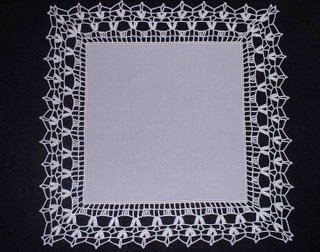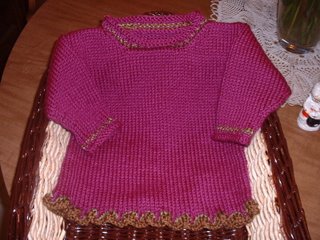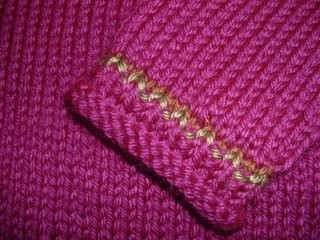
But had I read the description more carefully, I would have noticed that the weight in the eBay listing was 2/23. So, what's wrong with this picture?
The wool I bought is lovely, but it is NOT from Jaggerspun. Jaggerspun Zephyr comes in 2/18 lace weight. (It also comes in DK weight.) This cone of yarn at 2/23 is somewhat thinner than the Jaggerspun Zephyr.
The seller called this yarn Zephyr, because that is what's on the label. In fact, if you hunt around, you'll find many different companies have a yarn called "Zephyr." So, what did I get for my $20?
How to Determine Yards Per Pound from a Cone Label
The cone label says the yarn is from Phoenix Dye Works in Cleveland, Ohio. The yarn weight on the label is 2/23. The actual weight is about 2.5 lbs, including the cone itself.
Jaggerspun lists its 2/18 wool/silk at 5,040 yards per pound. I know that 2/23 is a skinnier yarn, and is going to have more yards per pound. So how many yards of yarn did I buy? And how does 2/23 yarn compare to 2/18 yarn?

The first number of the fraction is the number of plies. A ply is a single strand, so I have two plies.
The second number of the fraction is the yarn thickness. The yarn thickness is determined by the number of times the yarn is spun at the worsted standard of 560 yards per pound.* (Cotton and linen use a different standard.)
The yards of yarn on my 2/23 yarn cone, which weighs about 2.5 lbs, could be calculated like this:
Multiply the bottom number times 560:
23 x 560 = 12,880
12,880 divided by 2 plies = 6,440 per pound
6,440 x 2.5 lbs (total weight) = 16,100 yards (wow!)
I don't know how much the cardboard cone weighs, but I would need to subtract it from the total weight to get an accurate number of yards. A good estimate would be about 0.10 lbs for the cone. In that case, I would substract 0.10 from the total weight of 2.5 lbs. Then I would calculate:
6,440 x 2.4 lbs (total weight minus the cone) = 15,456 yards.
Truthfully, I will probably never use the entire cone of this yarn, even it were less than 10,000 yards.
*Note: After some additional reading, I corrected the worsted standard to 560 yards per pound. This seems to be the most often used number. Some websites use 500, but that seems to be the minority.
The Shetland Lace Shawl
I decided to knit Shirley Paden's Shetland Lace Shawl from Vogue Knitting Fall 2005 with my now infamous Zephyr yarn. This must be my favorite issue of VK, since I've made at least three items from it. 
If you recall, the lace shawls in this issue did not come with charts! Lace knitters around the world were up in arms about this. If you are a lace knitter, you know what I mean. Vogue called it a print space issue and promised to post the charts on their website.
For me, charts are a necessary part of any lace pattern. If a pattern doesn't have a chart, I'll make one myself. A chart allows you to see where the increases and decreases fall in relation to the previous row. Have you ever tried to knit a lace pattern like this?:
Row 16: 1 selvage st, k2, yo, k2tog, k1, yo, sk2p, *yo, k1, k2tog, yo, k3, yo, k2tog, k1, yo, sk2p; rep from *, end yo, k1, k2tog, yo, k2, 1 selvage st
Imagine reading rows and rows of this, without seeing on a chart where the yarnovers are supposed to line up with the previous row's yarnovers.
And, to make it even tougher, this is a Shetland lace pattern, with knitted lace on every row -- no plain rows. Technically, "knitted lace" is lace on every row. "Lace knitting" is lace on every other row, with plain knitting on the alternate rows.
It took a few months before VK finally published the charts for the Fall 2005 lace shawls on its website. The Shirley Paden Shetland Lace shawl was my favorite. I began to knit with a size 6 needle, then decided the gauge was too large and ripped it out. I settled on a size 4 needle.
With this type of knitted lace, it's difficult to see the pattern unless you stretch out the piece. I stretched it as much as possible and got a good look at the Webs, Spiders and Diamonds in the Shetland lace. The shawl will have four pieces which will be sewn together. The center will be two rectangles, grafted together. A separately knitted lace collar will be sewn to one long side. Finally, a knitted lace edging will go around the entire shawl. This is a big project, and I hope to learn more about Shetland lace shawl construction along the way.







